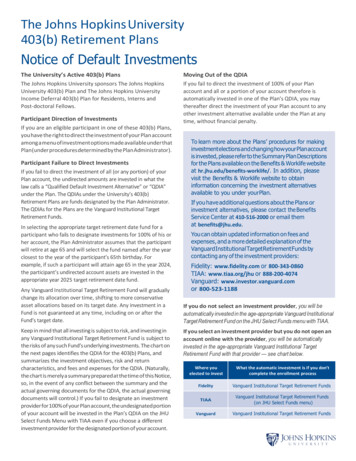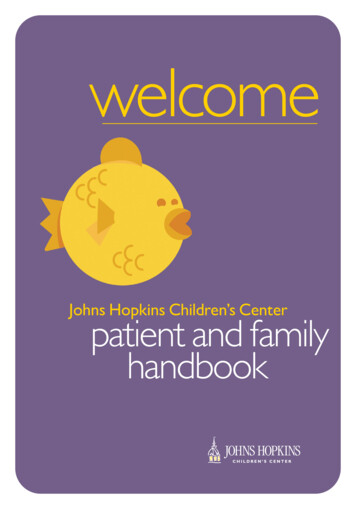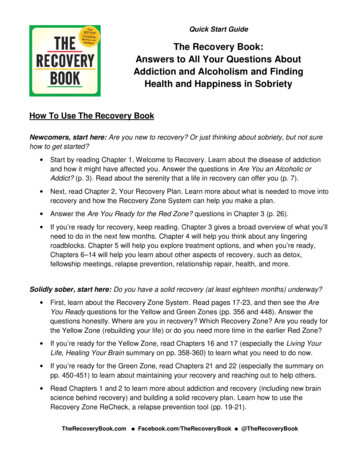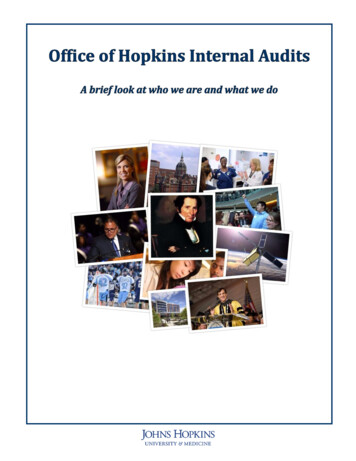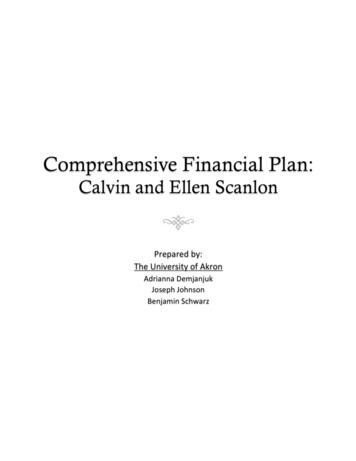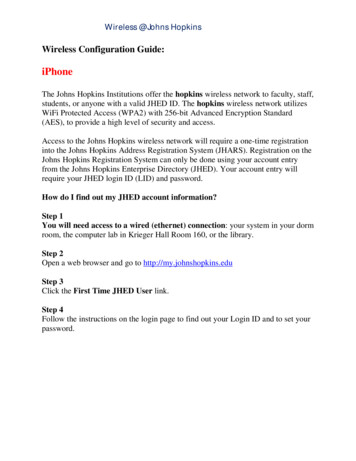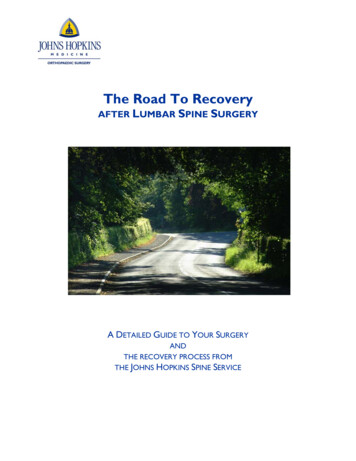
Transcription
The Road To RecoveryAFTER LUMBAR SPINE SURGERYA DETAILED GUIDE TO YOUR SURGERYANDTHE RECOVERY PROCESS FROMTHE JOHNS HOPKINS SPINE SERVICE
The Road To Recovery after Spine SurgeryTABLE OF CONTENTSIntroduction3Type of Surgery6Preparing for Surgery7Day of Surgery11Days after Surgery12Exercises in the Hospital13Going Home after Surgery14Ways to Avoid Twisting and Bending after Surgery17Proper Lifting Technique18Proper Ways to Push and Pull after Surgery20Sleeping after Surgery21Sitting after Surgery22Sitting at Your Desk after Surgery236 Week Follow-Up Appointment24Exercises at 6 Weeks after Surgery25What if My Expectations of Surgery are Not Met?27Additional Resources and Phone Numbers28Benefits of Quitting Smoking29Hotel Accommodations31Johns Hopkins Medical Campus Map352
The Road To Recovery after Spine SurgeryThis book will:- Prepare you for surgery- Explain what to expect during and after surgery- Guide you through the recovery processThe most important thing to remember is the sooner you return to being active –the sooner you will be on the road to recovery.The Johns Hopkins Spine Service is dedicated to returning you to an activelifestyle. Each member of the spine team has contributed to this book and ishere to answer any question. You can also access the book on our website athttp://www.hopkinsortho.org/surgery guide.html.Thank you for choosing us!Johns Hopkins Outpatient CenterDepartment of Orthopaedic Surgery601 N. Caroline StreetBaltimore, MD 21287410-955-6930Johns Hopkins at Greenspring Station10753 Falls Road, Suite 215Lutherville, MD 21093410-583-28503
The Road To Recovery after Spine SurgeryThe first step on the road to recovery is learning how to play an active role inyour care.Before proceeding with surgery, it is important to become an advocate foryourself. Make sure you understand the surgery and what to expect in the weeksand months following.So the idea is for you to be Pro-Active. This means you should seek outinformation and help from the health care providers around you. It is a good ideato take control, make decisions, and find your best road to recovery. To not bepro-active means you run the risk of having others make decisions for you.These decisions may not be in the best interests of you and your family.Success at being pro-active depends on knowing your rights as a patient. Theserights are: The right to considerate and respectful careThe right to obtain complete and current information concerning yoursurgeryThe right to receive information necessary to give informed consent priorto your surgeryThe right to be informed of the medical consequences of surgeryThe right to every consideration of privacy concerning careAnd the most important right:The right to ask questions!4
The Road To Recovery after Spine SurgeryWe know the idea of surgery can cause anxiety and leave you with manyunanswered questions. Your questions are extremely important to us and wehope that we can make you feel more at ease in the days prior to and after yoursurgery.Our intention in constructing this booklet is to allow you to become as involved inyour surgery and recovery as your surgeon and the staff.We approach surgery as a team with you being the most valuable player.Each surgery is quite different than the next and it is important that you and yoursurgeon know what to expect of each other.What Is a Lumbar (Low Back) Fusion?5
The Road To Recovery after Spine SurgeryA fusion stabilizes the vertebrae of the spine creating less chance for slippage ofthe discs. Bone from the iliac crest (hip), local bone from the operative site,allograft bone and other bone may be used as a bone graft. The graft is insertedbetween the vertebrae and then rods and screws are placed. The bone from thehip often is removed through the same incision leaving the patient with only oneincision postoperatively. Surgery will last approximately 4 to 8 hours.You will be in the hospital approximately 5 to 7 days and may go to arehabilitation unit after the 5 to 7 days in the hospital.Some people will undergo a staged surgery. This will entail a posterior fusion aswell as an anterior fusion. The anterior surgery is done through an incision in theabdomen. In most cases the posterior fusion is done first and then a date for asecond stage anterior surgery will be established after completion of the firststage.You will be in the hospital approximately 5 to 7 days and may go to arehabilitation unit after the 5 to 7 days in the hospital.The stay after the anterior surgery is approximately 2 to 5 days.What Is a Lumbar (Low Back) Laminectomy?A laminectomy is a procedure which involves removing bone of the vertebrae toallow for more space for the nerves. It relieves pressure on the nerves anddecreases symptoms such as numbness, tingling, pain and weakness.Surgery will last approximately 2 to 3 hours.You will be in the hospital approximately 3 days.What is a Lumbar (Low Back) Discectomy?Pain radiation down the legs may be due to a disc bulge or disc herniation. Adiscectomy is the removal of the piece of disc or the entire disc that is puttingpressure on the nerves and causing your leg numbness, tingling, pain orweakness. Surgery will last approximately 2 to 3 hours.You will be in the hospital 1 night. You will go home the next day.PREPARING FOR SURGERY6
The Road To Recovery after Spine SurgeryNo matter what surgical procedure you are getting ready to undergo, thereare general guidelines that will help you prepare for your upcomingsurgery. Your cooperation is greatly appreciated in this joint effort.Make sure you understand what to expect from the surgeryMany people will suffer from back pain as well as leg pain. Make sure youdiscuss the goals of surgery with your surgeon. If you are suffering from bothback and leg pain, the chances of surgery resolving your leg pain are very highcompared to relieving your back pain.Complete the on-line patient surveyAs part of our continuing effort to provide the best care to our patients, weroutinely collect information through a web-based survey on all patients bothbefore and after surgery. This survey assesses current pain level, functionalability, and beliefs about healthcare and wellness. The information is provided toyour surgeon to help improve surgical care and management of your recovery.The survey also collects outcome information that is essential to the ongoingresearch efforts of The Johns Hopkins Spine Service. If you haven’t alreadycompleted the survey on your first visit, please go to http://sorc.jhmi.edu/Survey.html and click on the lumbar survey link. You will need your Medicalrecord number to access the survey. This can be found on the checkout form thatyou received at one of your clinic visits to the Johns Hopkins Spine Service. Ifyou cannot locate your record number, please contact your surgeon’s office forhelp.7
The Road To Recovery after Spine SurgeryStop smokingIf you are a current smoker, we advise that you quit smoking tobacco products atleast 1 month prior to surgery. Nicotine, in any form, is a hindrance to bonefusion and healing. Because Nicotine is the source of the problem when itcomes to healing and bone fusion, smoking cessation products such asNicorette gum or nicotine patches must be discontinued as well. Pleasediscuss smoking cessation plans with your medical doctor. There are newmedications available to help with this.Obtain medical clearance You will be expected to see your medical doctor and likely visit the JohnsHopkins Preoperative Evaluation Center for a physical examination,medical history and other testing. Please call your surgeon’s office todiscuss this. If you have heart disease, diabetes or any other diseases and arefollowing by a specialist, you will be expected to receive clearance fromthem prior to surgery. This clearance must be in writing and sent toyour surgeon’s office. Your surgeon will discuss whether is it necessary for you to meet with oneof our anesthesiologists prior to your surgery based on your health historyand age. If you are suffering from extreme stress or anxiety or have signs ofdepression, make sure you address this with your primary health providerand spine care team before surgery. If you see a pain management specialist, make sure to share the news ofyour surgery.8
The Road To Recovery after Spine SurgeryPerform the required testing: WITHIN 30 DAYS OF YOUR SURGERY DATEA comprehensive history and physical will be required that will include: CBC with differential, Full chemistry, ESR, PT/PTTUrinalysis with cultureEKGChest x-rayType and screen can only be performed here at Johns HopkinsIf you have a history of cardiac disease then a stress test will be neededIf you choose to have your testing done at Johns Hopkins, please call yoursurgeon’s office and they will make an appointment for you in our PreoperativeEvaluation Center.Instructions for medications prior to surgery You will be required to STOP any nonsteroidal anti-inflammatoriessuch as Ibuprofen (Advil, Motrin), Naprosyn (Aleve), Celebrex, Mobic,Indocin, and Lodine 7-10 days prior to your surgery. You will need to STOP taking aspirin and any anticoagulants includingcoumadin and Plavix , Lovenox . Please check with your health careprovider about when and how this should be done. Please STOP taking any herbal supplements and certain vitamins 7-10days prior to surgery including but not limited to St. John’s Wart, Garlic,Ginseng, Gingko Biloba, Vitamin E and Vitamin C, as these tend to thinyour blood. Diabetic patients should not take any oral hypoglycemic agents andinsulin products the morning of surgery. Metformin (Glucophage) isthe most vital to make sure to avoid. You should not take any diuretics the morning of surgery (i.e. Lasix,HCTZ) (Unless you have congestive heart failure) You should not take any ACE/ARB the morning of surgery. These areclasses of antihypertensive medications. Examples include Lisinopril,Lotrel, Captopril, Lotensin, Monopril, Prinzide, Atacand, Benicar, Diovanand Avalide.9
The Road To Recovery after Spine SurgeryPerform the following tasks before surgery Make sure you review the postoperative exercises and restrictions whichinclude no bending, twisting, and lifting greater than 5 pounds. Arrange for a family member or friend to check on you in your home andhelp you through the first couple of weeks after your surgery. The type ofsurgery you have will determine the length of time you will need help. If you are coming from out of town, you may want to stay in a hotel thenight before surgery. The morning surgery begins at 7:30am and you areexpected to arrive at the pre-operative area 2 hours prior to your surgery.If you would feel more comfortable staying in the Baltimore areapostoperatively, we can help you find accommodations at a discountedrate. Please see the list of hotels that offer the discounted Johns Hopkinsrate at the end of the book. Arrange to have someone drop you off the morning of surgery and pickyou up after discharge. You will not be able to drive yourself home on theday of discharge. Your surgeon and staff will send you a list of medications to avoid prior toyour surgery. Please pay special attention to this information as you willhave to stop some of the medications 5-7 days prior to surgery. You will be required to fast the night before surgery, and will be givenguidelines before surgery. You should not have anything to drink or eatafter midnight the night before surgery. Please follow the attached instructions regarding the surgical cleansebefore surgery. Some surgeons will ask that you use Chlorhexadine,which is an antiseptic skin cleanser. Pack lightly for your hospital stay. Please do not bring any valuables tothe hospital. It is a good idea to bring sneakers and comfortable clotheswith an elastic waistband.10
The Road To Recovery after Spine SurgeryDAY OF SURGERYWhat are your responsibilities the day of surgery?Please arrive 2 hours prior to your scheduled surgery time (i.e. if your surgery is7:30am, please arrive at 5:30am) and report to Zayed 3 (pre-op area) themorning of surgery.It is essential that you bring your MRI, Cat scans, and x-rays on the day ofyour surgery if you have not given them to your surgeon already.If you have brought a copy of your advance directive or living will, please providethe pre-operative nurse with a copy.What happens in the pre-op area?You will meet with a provider from the spine team who will complete the surgicalconsent forms with you. This person will also confirm the type of surgery andinitial the surgery site. You will also meet with the anesthesiologist prior to yoursurgery. He or she will begin an IV as well as place TED stockings on your legs.You will wear TED stockings throughout your hospital stay as well as 1 to 2weeks after you are discharged from the hospital. These stockings help avoidleg swelling and clots.Once you are anesthetized (put to sleep), a foley catheter will be inserted whichwill empty your bladder during surgery. Shortly following the surgery and onceyou are moving out of bed, this catheter will be removed.Where will you go immediately after surgery?Once your surgery is over, you will be transferred to the recovery room. Onceyou are stable, you will be transferred either to the surgical intensive care unit(SICU) or to Zayed 11, an orthopaedic unit, on the same day of surgery.If you are moved to the SICU, you will spend approximately 1 night until you arestable enough to be transferred to Zayed 11.11
The Road To Recovery after Spine SurgeryDAYS AFTER SURGERYAfter surgery, you will be advised not to twist or bend.Most people will not need to wear a brace after surgery. However, your surgeonwill inform you if a brace is required and one will be ordered while in the hospital.During the days following your surgery, physical and occupational therapists willwork with you while in the hospital. They will provide you with exercises to regainyour strength and with equipment to help you resume your normal activities, suchas a reacher to pick things off the floor or a cane or walker to assist with safewalking. They will also teach you get out of bed and to sit in a chair. Once youare tolerating getting out of bed and to a chair, a physical therapist will work withyou to begin walking. This usually occurs the day after your surgery. Once youare tolerating walking in the halls with the physical therapist, you will bereintroduced to stairs.Who are the other people you will meet in the hospital?A social worker and a home care coordinator will discuss your home needs whileyou are in the hospital and order durable medical equipment such as braces, andwalkers, which can be delivered to your home.If you feel the need to speak with pastoral counseling, there are chaplains,rabbis, priests or ministers of your faith.Johns Hopkins Hospital does hold mass every Sunday and patients and theirfamily members are welcome to attend.What about pain management and diet advancement after surgery?Immediately following surgery, you will be given pain medications through an IV.The IV medication will be given through a PCA (Patient-Controlled Analgesia)pump. This form of medication allows you to control your own medication.Shortly after surgery you will then be given oral pain medications and the PCAwill be stopped.Once you are tolerating clear liquids, your diet will be advanced slowly until youare ready for a regular meal again.12
The Road To Recovery after Spine SurgeryPlease take the time to review some of the exercises you will do in the hospital.13
The Road To Recovery after Spine SurgeryGOING HOME AFTER SURGERYMost people will be discharged home. But for some, rehabilitation may benecessary as a bridge to going home. Johns Hopkins has a rehabilitation floorand your insurance may cover the stay. Depending on availability, you may alsogo to our sister rehabilitation unit at Good Samaritan Hospital or othersdepending on your needs.Pain medicationsYou will be discharged with pain medications. Be sure to drink plenty of fluids,take stool softeners prescribed and increase your fiber intake while takingnarcotic medications as they tend to cause constipation.Do not allow constipation to progress more than 2 days withoutintervention i.e. laxatives.You should begin to wean yourself off of the pain medications with a goal ofstopping within 3 months from surgery. If you are still requiring narcoticmedications after 3 months, we will be happy to help you find a painmanagement specialist either here at Johns Hopkins or in your local area.Medication restrictions after a Lumbar (Low Back) Fusion SurgeryPlease ask your surgeon how long you should refrain from non-steroidal antiinflammatory medications. Usually patients are asked to avoid thesemedications for 3 months after surgery but this decision can be made by yoursurgeon.These medications include, but are not limited to:Ibuprofen (Advil, Motrin), Naprosyn (Aleve), Celebrex, Mobic (Meloxicam),Indocin, Voltaren, Aspirin, and Lodine.Surgical incision carePlease Remember: **If you notice any increased or change in drainage,redness, swelling, or have a fever of 101.5 or greater, please call yousurgeon’s office immediately or go to the emergency room.Your surgical incision may be closed with dissolvable sutures and steri-strips,staples or sutures. If you have staples or visible sutures, these will need to beremoved 10 to 14 days after your surgery. Arrangements for a home care nursecan be made in the hospital by our home care coordinators. If you do not qualifyfor in-home care by your insurance company, you will need to make anappointment for staple/suture removal with your PCP or surgeon’s office.14
The Road To Recovery after Spine SurgerySurgical incision careWhile you are in the hospital, you will wear a dry gauze dressing. Once yourincision is no longer draining, you may take off the dressing and leave theincision open to air.Do not apply any ointments or lotions to the incision while it is healing.YOU MAY NOT BATHE IN A TUB, SWIM OR USE A HOT TUB UNTIL YOURINCISION IS HEALED AND UNTIL YOU HAVE SEEN YOUR SURGEON.Sexual activityYou can resume sexual activity when you are feeling up to it. You may findcertain positions will be more comfortable than others. Caution and commonsense are recommended and a safe rule of thumb for positions is if it hurts, thendon’t do it.DrivingYou can drive when you feel up to driving and are not taking narcotic painmedications or after clearance by your surgeon. This is usually 2 to 3 weeksafter a laminectomy and discectomy and 4 to 6 weeks after a lumbar fusion.Narcotic pain medications will delay your reflex time. Begin with short trips firstand get out of the car every 30 to 45 minutes to walk around and reposition.Return to workNaturally, you will feel tired and weak after surgery. You will begin to feelyourself after 2 to 3 weeks and improve over the following weeks. You shouldtell your employer you will be out of work for approximately 8 to 12 weeks butmay be able to return earlier than that.15
The Road To Recovery after Spine SurgeryWalking is the best activity you can do for the first 6 weeks after surgery. Youshould start out slowly and work up to walking 30 minutes at least twice a day.Do not be surprised if you require frequent naps during the day. Between thenarcotic pain medications you will be discharged with and the stress your bodyhas undergone in surgery, you will be tired.Don’t forget about your restrictions for the first 6 weeks after surgery. You needto avoid twisting and bending. You also need to avoid lifting, pushing or pullingobjects greater than 5 lbs.Lifting and activity restrictions will be gradually removed as the healingprocess takes place. Remember to keep your spine in the neutral positionand maintain good posture throughout the day.16
The Road To Recovery after Spine SurgeryBelow are some ways for you to avoid twisting and bending during dailyactivit
rehabilitation unit after the 5 to 7 days in the hospital. The stay after the anterior surgery is approximately 2 to 5 days. What Is a Lumbar (Low Back) Laminectomy? A laminectomy is a procedure which involves removing bone of the vertebrae to allow for more space for the nerves. It relieves pressure on the nerves and


